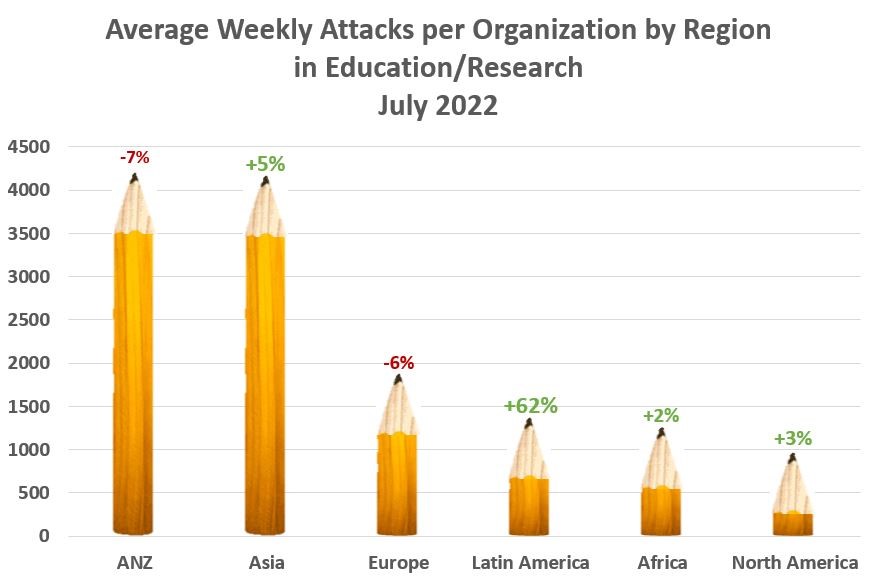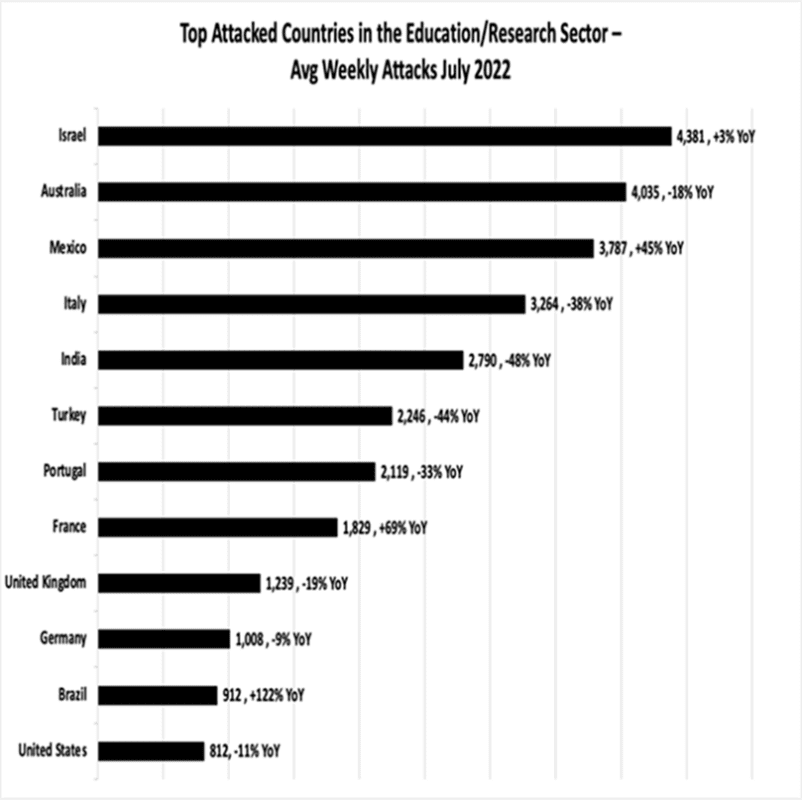Cyberattacks see 114% Increase in the last 2 years on Education Sector before Back-to-School

With back-to-school around the corner, Check Point Research (CPR) sees the highest volume of cyberattacks on the education and research sector. Hackers sent the most cyberattacks on the education and research sector every month in 2022 and in 2021, marking a 114% increase these past two years. The shift to remote learning during the COVID-19 pandemic has increased the attack surface and widened the door for hackers to infiltrate school networks. In the month of July, weekly cyberattacks by hackers on education and research organizations are double the number compared to other industries’ average
CPR is sharing new data on the trend by region and country.
- Latin America saw a 62% increase in cyberattacks in July 2022
- Brazil, France and Mexico were the countries that saw the highest increases in cyber attacks
- CPR issues over a dozen cyber safety tips for students, parents and schools
Check Point Research (CPR) is seeing the largest volume of cyberattacks on the education and research sector, compared to all other industries.
Key Numbers:
- Education/Research sector experienced the highest volumes of attacks every month in 2022 and in 2021 worldwide
- In July 2022, the Education/Research sector shows more than double the number of weekly cyber-attacks compared to the other industries’ average
- Education and Research still leads as the most targeted industry, with an average of 2,297 attacks against organizations every week in the 1H of 2022, showing a 44% increase compared to the 1H of 2021
Cyber Attacks on Education/ Research by Region
Most Attacked Regions
- ANZ 4,176 attacks per organization every week (7% decrease compared to July 2022)
- Asia 4,171 attacks (5% increase)
- Europe 1,861 attacks (6% decrease).
- Latin America 62% increase compared to July 2021

Cyber Attacks on Education/ Research by Country

Quote: Omer Dembinsky, Data Group Manager at Check Point
“Students, parents and schools are tempting targets for hackers, mainly because of data. There’s lots of it. From gradebooks to online assignments, hackers have far more access points to sensitive information and data. Data is leverage for hackers and can be used to orchestrate ransomware attacks. The COVID-19 pandemic forced a big shift to remote learning. However, the shift to remote learning has increased the potential attack surface of hackers significantly. In other words, the door is much wider for hackers to infiltrate school computer networks. All it takes is for one teacher, student, or parent to click on a phishing email created by a cyber criminal and a ransomware attack could be underway. Education and Research is by far the most attacked industry sector, seeing a 114% increase in the past two years. With back-to-school right around the corner, we are urging students, parents and school to exercise the highest level of cyber security practices. Cover your webcams when not in use. Talk to your kids about phishing. And vet 3rd party applications and more.”
Safety Tips
Tips for Students
- Cover your webcam. Turn off or block cameras and microphones when class is not in session. Also, be sure that no personal information is in the camera view.
- Only click on links from trusted sources. When in the remote school collaboration platform, only click on links that are shared by the host or co-hosts, when directed to do so
- Login directly. Always be sure to log in directly to your schools’ remote school portals; do not rely on email links, be aware of lookalike domains on public tools.
- Use strong passwords. Hackers often attempt to crack passwords, especially short and simple ones and adding complexity into your password prevents that.
- Never share confidential information. Students should not be asked to share confidential information via online tools. They should keep all personal information off cloud storage platforms.
Tips for Parents
- Talk to your kids about phishing. Teach your children to never click on links in email messages before they first check with you.
- Call out cyberbullying. Explain to your children that hurtful comments or pranks delivered online are not OK. Tell them that they should immediately come to you if they experience or see someone else experience cyberbullying.
- Explain that devices should never go unattended. Your kids will need to understand that leaving a device for unwanted hands can be detrimental. Hackers can login to your devices assume your child’s identity online.
- Set parental controls. Set the privacy and security settings on websites to your comfort level for information sharing.
- Increase awareness. Cybersecurity literacy is an important skill set, even for the youngest schoolchildren. Invest the time, money and resources to ensure your child is aware on cyber security threats and precautions.
Tips for Schools
- Get anti-virus software. Making sure your children’s laptops and other devices are protected by antivirus software prevents them from accidentally downloading malware. Turn on automatic updates for that anti-virus software.
- Establish a strong online perimeter. Schools should establish strong boundary firewalls and internet gateways to protect school networks from cyber-attacks, unauthorized access and malicious content.
- Check third party providers thoroughly. Schools should ensure they vet thoroughly all third party platform providers they use.
- Monitoring the system, constantly. Schools must monitor all of their systems continuously and analyze them for unusual activity that could indicate an attack.
- Invest in online cyber security education. Ensure that members of staff understand the risks. Conduct regular sessions for students so they are aware of the latest cyber security threats.











Responses